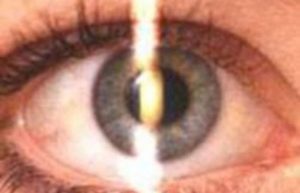Introduction – A spasm of accommodation (also known as a ciliary spasm, an accommodation, or accommodative spasm) is a condition in which the ciliary muscle of the eye remains in a constant state of contraction normal accommodation allows the eye to “accommodate” for near-vision. However, in a state of perpetual contraction, the ciliary muscle cannot relax when viewing distant objects. This causes vision to blur when attempting to view objects from a distance.
Causes-
1. Drug induced spasm of accommodation is known to occur after use of strong miotics such as echothiophate and diisopropy1 fluorophosphate(DFP)
2. Spontaneous spasm of accommodation is occasionslly found in children who attempt to compensate for a refractive anomaly that imparis their vision. It usually occurs when the eyes are used for excessive near work in unfavourable circumstances such as bad illumination, bed reading position, lowered vitality , state of neurosis , mental stress or anxiety.
3. Iridocyclitis may also be associated with ciliary spasm.
4. Spasm of near reflex is a characteristic clinical syndrome, often seen in tense or disturbed individuals who present with excessive accommodation , excessive convergence and miosis.
5. Lesions of brainstem in their irritative phase,
e.g. tabetic crisis, epidemic encephalitis and meningitis may be associated with ciliary spasm.
6. Toxic reaction of exogenous poisons, e.g. sulphonamides and arsenic, or even smoking can also sometimes cause spasm of accommodation .
Clinical features-
Symptoms commonly associated with accommodative include blurred vision, changing vision, headaches, eye strain, and difficulty concentrating.
Who gets accommodative spasm?
An accommodative spasm most often occurs when a person is under stress or when a person is reading for a long period of time. It can happen to students when they are taking notes for a long time or concentrating during a test. Objects at distance can become harder and harder to see.
When accommodative spasms start happening more frequently, it can cause a person to become worried about their vision. The accommodative spasm can then become worse because of stress.
Treatment-
Cycloplegic Eye Drops (Dilation)
Spasm of accommodation is frequently resistant to treatment. However, some patients do find relief through the use of daily eye dilation with cycloplegic drops. One side effect of cycloplegic drops is that they often have BAK as a preservative ingredient, which, with daily use, can erode the tear shield:
At each administration of an eye drop containing benzalkonium chloride, its detergent effect disrupts the lipid layer of the tear film. This cannot be regenerated and can no longer protect the aqueous layer of the tear film, which evaporates easily. In these circumstances, the cornea is exposed and eye dryness occurs. In addition, benzalkonium chloride has a cellular toxicity on caliciform cells, entailing a reduction in the amount of mucin, an additional reason for disrupting the tear film.
In fact, none of the cycloplegic drops used to treat Spasm of Accommodation in the United States are available without BAK. This unfortunately makes treatment much more difficult as the side effect of dry eyes and corneal damage can occur. France, Australia, Canada, and the United Kingdom do have limited availability of BAK-free eye drops available in unidose, and they must be imported to the United States with a enclosed with the imported prescription.
Due to the high potential of tear shield damage with long-term use and the associated dry eye condition caused by cycloplegic eye drops with BAK (preservative), many physicians do not recommend cycloplegic eye drops. In difficult cases, “cycloplegic agents are highly favored to break spasm quickly and may be more economical compared to other conventional therapies”
Cyclopentolate, Atropin, Tropicamide, and Homatropin are the typical cycloplegic eye drops used once daily to treat spasm of accommodation by relaxing the ciliary muscle. One side effect is blurred vision since these induce dilation.
Vision Training
Vision therapy administered by a trained optometrist has shown a success rate of over 70%.
Surgery
Multifocal intraocular lens implantation is a new possible treatment involving clear lens extraction and multifocal intraocular lens implantation but it may not be appropriate for patients who have had resistant spasm of accommodation for a long period of time.









